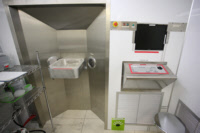Equipment
| Lab and Coral Name | ICL / Oxford-100 |
| Model | Oxford Plasmalab System 100 |
| Specialist | Robert Bicchieri (Eric Lim) |
| Physical Location | 2F 1-NorthExtension Deposition |
Classification
| Process Category | Deposition, Etch |
| Subcategory | PECVD, RIE |
| Material Keywords | SiO2, SiNx, Dielectrics, CMOS Metals, Non-CMOS Metals, Other Polymers |
| Sample Size | 6" Wafers, 4" Wafers, Pieces |
| Alternative | TRL / sts-CVD, TRL / plasmaquest |
| Keywords | single wafer, multiple pieces, load lock, top side of sample, anisotropic etch, conformal dep, vacuum, plasma, temperature |
Description
The Oxford-100 is a dual chamber plasma etch and deposition tool. It can deposit silicon dioxide, nitride, SiC, a-Si, and TEOS. The deposition can take place at low and high frequencies (similar to sts-CVD), allowing stress-balancing of deposited films. For dielectric deposition, this is the only RED tool that can deposit TEOS. For other dielectrics, the sts-CVD is an equivalent tool, but the Oxford-100 has lower pinhole densities. The etch chamber of the Oxford-100 is able to etch dielectrics and certain metals. However, it is not a dedicated metal etcher (it does not do a post-etch water rinse to remove trapped chlorine that may continue to attack the metal).
| Best for | Depositing dielectrics and etching both dielectrics and metals |
| Limitations | The loadlock and venting is slow, adding 5-7 minutes of roundtrip time per wafer. This makes recipe developing time consuming. For large number of wafes, alternative tools may offer a better throughput. |
| Characteristics/FOM | Gases: C2F6,SF6,Cl2,He,O2,NH3,SiH4,BCl3,CH4. N2O is for etchback cleaning in the dep chamber. Materials: TEOS,a-Si,SiC,SiO2,SiNx |
| Caution with | The control software's timer is poorly implemented, and sometimes can run behind by forgetting to count. This can result in longer than expected run times. Be present during the run and use manual timer to check when using a timed etch oir deposition. The loadlock O-ring comes loose during opening, and needs to be carefully placed back |
| Machine Charges | 7/wafer+thickness |
Documents
SOP
| Oxford 100 | SOP for the Oxford 100 PECVD/RIE |
Process Matrix Details
Permitted
Been in the ALDSamples that have been in any of the ALD systems
, Pyrex SubstratesPyrex substrates can be a concern due to high sodium content, which contaminates CMOS frontend tools
, III-V SubstratesAny III-V substrates, e.g. GaAs, GaN, InP, and so on. Note though that many common III-V substrates will also carry the Au flag, but there are some GREEN III-V substrates.
, Germanium on surfaceSamples with germanium on the surface (typically grown films)
, Germanium buriedSamples with germanium buried below a different film
, PiecesWafer pieces may not be handled by the equipment, and are harder to thoroughly clean - preventing them from running in certain tools.
, Gold or RED color codeRED color code substrates. These are gold-contaminated or have been processed in gold contaminated tools. Gold and other metals can contaminate silicon devices (GREEN color code) and have to be separated.
(Adds), Any exposure to CMOS metalIf the sample had ever seen a CMOS metal (or a tool that accepts CMOS metal), then some frontend tools could be contaminated by this.
(Adds), CMOS metal on surfaceCMOS compatible metals exposed on the surface. These are Al,Ni,Pt,Ti,TiN. Other metals such as Au are *NOT* part of this.
, CMOS metal buriedCMOS compatible metals covered entirely by a different material. These are Al,Ni,Pt,Ti,TiN. Other metals such as Au are *NOT* part of this.
, Been in the STS DRIEThe DRIE etch leaves behind polymer residues on the sidewall ripples, which can be a contamination concern for some tools.
, Been in the SEMA sample viewed in the SEM must have used the appropriate chuck to avoid cross-contamination
, Been in the Concept1The Concep1 deposits dielectrics on GREEN wafers, however it also accepts metal and there can be cross-contamination for diffusion area
, Has PhotoresistSamples with photoresist cannot be exposed to high temperatures, which is typical in deposition tools. Outgassing can be a concern.
, Has PolyimidePolyimide is a very chemically resistant polymer, and can tolerate higher temperatures but cannot be exposed to typical PECVD deposition temperatures or diffusion furnaces. Outgassing can be a concern.
, Has Cured SU8Not fully cured SU8 residues can heavily contaminated plasma chambers or destroy other user's samples, but fully cured SU8 is permitted in certain tools.
, Coming from KOHAfter a KOH etch, the samples must receive a special clean because the K ions are highly contaminating to CMOS frontend tools
, Coming from CMPAfter a CMP, the samples must receive a special clean, because the slurry residues otherwise introduce contamination and particles.
Not Allowed
Ever been in EMLSamples from EML are never permitted to return to ICL or TRL
For more details or help, please consult PTC matrix, email ptc@mtl.mit.edu, or ask the research specialist (Robert Bicchieri)
